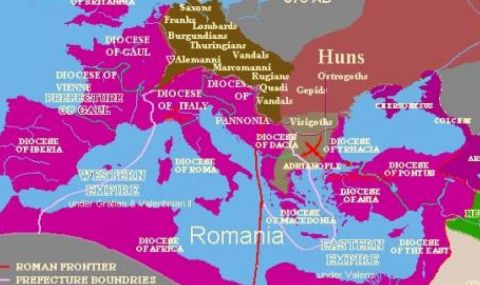On January 17, 395, the Roman Empire was divided between the sons of Emperor Theodosius I into an Eastern Empire with ruler Arcadius and a Western Empire with ruler Flavius Honorius.
Flavius Theodosius, also known as Theodosius I or Theodosius the Great, was Roman Emperor from 379 to 395. After the disastrous Battle of Adrianople in 378, Theodosius was summoned to the East by the Western Roman Emperor Gratian, who appointed him commander of the Roman troops in Thrace, and then declared him co-emperor.
The new emperor managed to deal with the Gothic threat with great resourcefulness. The main tool of Theodosius I's policy was the conclusion of the so-called. foedus, treaties according to which the newcomers became federates - they retained their relative autonomy, but were obliged to serve the empire as auxiliary fighters. During the period until the middle of the 5th century, the Goths made up the majority of the army of the Eastern Empire.
In church matters, Theodosius I began a struggle to impose the decisions of the First Ecumenical Council in Nicaea. The activities of the Arians in his domains were particularly affected, who, together with the pagans, fell out of favor. In May 381, the Second Ecumenical Council was convened in Constantinople, at which a new patriarch of Constantinople was elected and the full text of the Symbol of Faith was adopted.
The power of the church had grown so much that when in 390 On the orders of Theodosius, Gothic mercenaries killed 7,000 people while suppressing riots in Thessalonica (today's Thessaloniki), the emperor was officially excommunicated by the influential bishop Ambrose of Milan. Only after public repentance was Theodosius again accepted into the ranks of believing Christians.
In the capital Constantinople at this time, the Forum of Theodosius with a triumphal arch, the Column of Theodosius and the Hippodrome were built. Peace reigned on the border with Persia. The Romans managed to add Western Armenia and Colchis to their possessions.
In 383, a military coup took place in the Western Empire against Emperor Gratian, who was overthrown and killed. Defending the rights of Valentinian II in Italy, Theodosius led a campaign against the usurper Magnus Maximus - supported by the barbarian federates, achieved victory and returned the throne to his co-emperor (388).
In 392, Valentinian II was killed and Theodosius was forced to fight again, this time against the Frankish general Arbogast and his puppet emperor Flavius Eugenius. The Eastern emperor defeated his opponent in September 394 and united the Roman Empire for the last time, but early the following year he died in Mediolanum (today Milan) of dropsy (edema).
Emperor Theodosius I was actually called the Great by church historians because he followed a firm and consistent policy in support of Christianity as the only religion in the Roman Empire and banned all other cults.
While in 313, Constantine the Great issued the so-called The Edict of Milan, which declared all religions in the empire equal, in 392 Theodosius even forbade the private practice of pagan religion. Most temples in many cities were closed or converted into churches, such as the Serapeum in Alexandria and the Temple of Vesta in Rome. In 393 the Olympic Games were held for the last time, after which they were also banned as pagan.
After his death on January 17, 395 in Milan, Theodosius the Great was buried in Constantinople. According to his will, the empire was divided between his sons Arcadius and Honorius, into the Eastern and Western Roman Empires, respectively.
